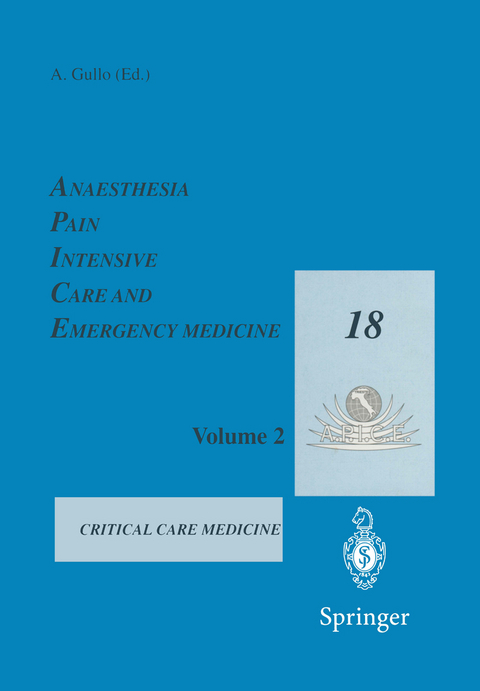
Anaesthesia, Pain, Intensive Care and Emergency Medicine — A.P.I.C.E.
Springer Verlag
978-88-470-0235-7 (ISBN)
Update and Perspectives in Critical Care.- Cardiac resynchronisation therapy.- Acute renal failure in the critically ill patient.- Research tool for the study of therapeutic intervention in acute respiratory failure.- Supportive measures to bridge the gap before transplantation in liver failure.- Multiple organ dysfunction after liver transplantation: a role for the quality of functional recovery of the newly grafted liver?.- Homeostasis and acid-base regulation.- Scoring system reinterpretation in critical care.- Paediatric anaesthesia in developing countries: 12 years’ experience in Bangladesh.- Acute head injury.- The subtle marker called age.- Non invasive cardiovascular monitoring: focus on “LIDCO”.- Thoracic impedance.- Transpulmonary thermodilution: analysis of beat by beat, peak pressure and stroke volume variations: GEDV, ITBV, EVLW.- Blood-volume measurement methods and evaluation of hepatic function with hydroxyethyl starch and indocyanine green.- Monitoring at the bedside of atrial natriuretic peptide serum level.- Tuberculosis in the intensive care unit.- Evidence-based medicine in the ICU: interests and limits.- Improving quality in the intensive care unit setting.- Lung.- Ventilation-induced lung injury and its prevention: the open lung concept.- Respiratory dead space and survival in the acute respiratory distress syndrome.- Molecular mechanisms of ventilator-induced lung injury: from laboratory to bedside.- Understanding pulmonary and extrapulmonary ARDS by a novel experimental model.- Microstructural evaluation of pulmonary oedema.- Present status of surfactant replacement therapy.- Combined spontaneous and mechanical ventilation in acute respiratory failure.- ARF and protective lung strategy — interpretation of randomised controlled trial.-Mechanical ventilation during an acute exacerbation of COPD.- Cardiovascular Critical Care.- Acute coronary syndromes: definitions and key points.- Biohumoural cardioprotective mechanisms, with particular reference to insulin as an endogenous cardioprotector.- Influence of diastolic mechanics on cardiac electrophysiology: effects on sino-atrial node function.- Myocardial radionuclide imaging in acute coronary syndromes.- Experience with levosimendan in the ICU.- Selected topics in cardiac critical care: cardiac arrhythmias, perioperative heart failure and hypertensive crises.- CPR.- Myocardial dysfunction following restoration of spontaneous circulation.- Vasoactive drugs during cardiac arrest: local and systemic effects.- Predictors of successful out-of-hospital defibrillation.- Early defibrillation.- Utstein style.- Clinical experience of public access emergency defibrillation.- Do-not-resuscitate orders - Do-not-attempt-resuscitation orders.- Sepsis and Organ Dysfunction.- Ongoing challenges in sepsis and organ dysfunction.- The microcirculation of the gut in sepsis.- Sepsis: early recognition and management at the bedside.- The neutrophil: balancing antimicrobial effectiveness and the potential for damage to the host.- Epithelial lung in host defence and signaling.- The complement system in sepsis: from new insights into its pathogenesis to future therapeutic approaches.- How hot are heat shock proteins in sepsis?.- Role of PAF and coagulation in sepsis.- Compartmentalisation of the inflammatory response.- Sepsis management in infants and children.- Adult nutrition in sepsis.- Continuous renal replacement treatment in sepsis: many opinions, little evidence.- Perioperative Medicine.- Preoperative assessment from a clinical point of view.- Intraoperative volume optimization.- News on muscle relaxants.- Cerebral protection during anaesthesia.- Anaesthesia and splanchnic perfusion.- Remifentanil+Desflurane for inhalational induction without airway irritation and rapid post-anaesthetic recovery. Preliminary results in 100 patients.- Perioperative ß-adrenergic blocking drugs. From concept to applications.- B-blockers in premedication of the cardiac patient — a must in 2003?!.- Interactions of anaesthetic drugs with herbal medicines.- Awareness during anaesthesia: incidence, clinical and legal aspects.- Infection control in operating theatres.- Perioperative medicine — organisation of operating theatres and recovery room.- Perioperative cardiac anaesthesia: anaesthesia for off-pump coronary artery bypass graft.- Perioperative paediatric anaesthesia.- Continuous peripheral nerve blocks in paediatrics.- Regional analgesia in children: which drug? Which block?.- Ketamine, a general anaesthetic agent and more. A review on its use in and out the clinical setting.- Neuroimaging studies on ketamine.- Neuroprotection by ketamine.- Pain relief by ketamine.- Neurotoxicity of ketamine and nitrous oxide.- Models of acute pain service.- Blood Transfusion.- Platelet transfusion: when, how and how much?.- Erythropoietin in the critically ill.- Acute normovolaemic haemodilution.- Neurological Illness.- Acute neuropathies in sepsis.- Stroke management in the early phase.- Guillain-Barré syndrome.- Trauma Operative Procedures.- Pre-hospital care and triage in trauma.- Severe thermal burn injury: assessment and early management.- Obstetrics.- Perioperative obstetric anaesthesia — haemorrhage and coagulation.- Caesarean section in an emergency.- Obstetric emergencies and anaesthesia.- Pre-eclampsia and anaesthesia.- Prevention and management ofeclampsia.- Palliative Care.- The organisation of palliative care.- Death in the ICU: why integrate palliative care?.- Nursing the dying in intensive care.- Planning, designing and writing up scientific research.
| Erscheint lt. Verlag | 4.2.2004 |
|---|---|
| Zusatzinfo | XXXI, 1259 p. In 2 volumes, not available separately. |
| Verlagsort | Milan |
| Sprache | englisch |
| Maße | 170 x 244 mm |
| Themenwelt | Medizin / Pharmazie ► Medizinische Fachgebiete ► Anästhesie |
| Medizin / Pharmazie ► Medizinische Fachgebiete ► Intensivmedizin | |
| Medizin / Pharmazie ► Medizinische Fachgebiete ► Notfallmedizin | |
| ISBN-10 | 88-470-0235-4 / 8847002354 |
| ISBN-13 | 978-88-470-0235-7 / 9788847002357 |
| Zustand | Neuware |
| Haben Sie eine Frage zum Produkt? |
aus dem Bereich


